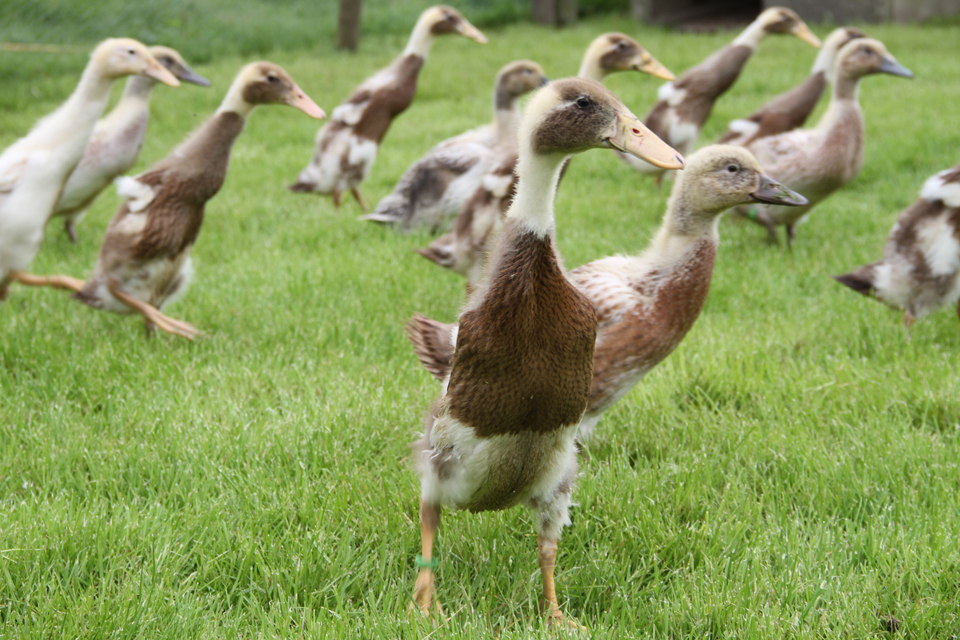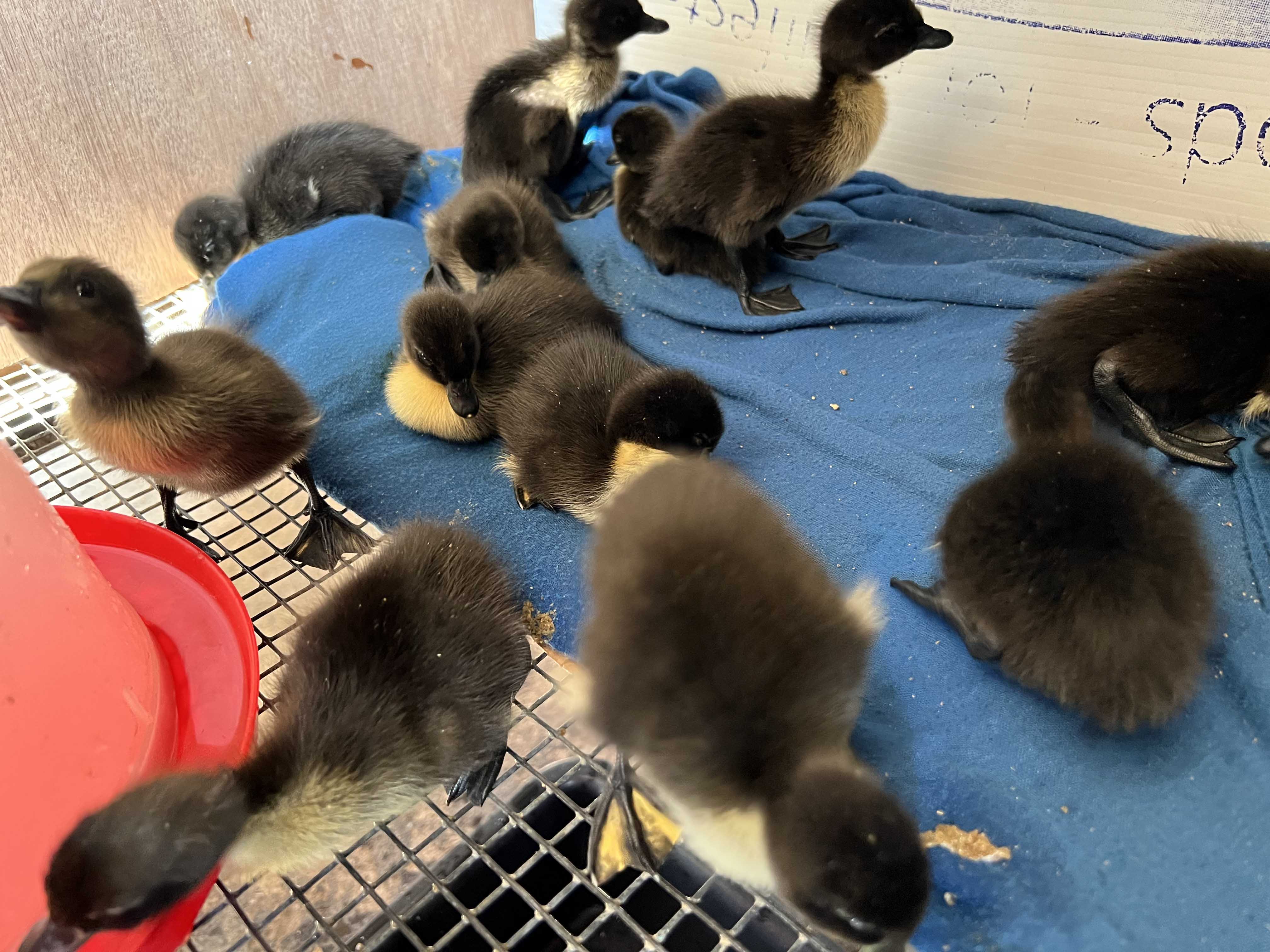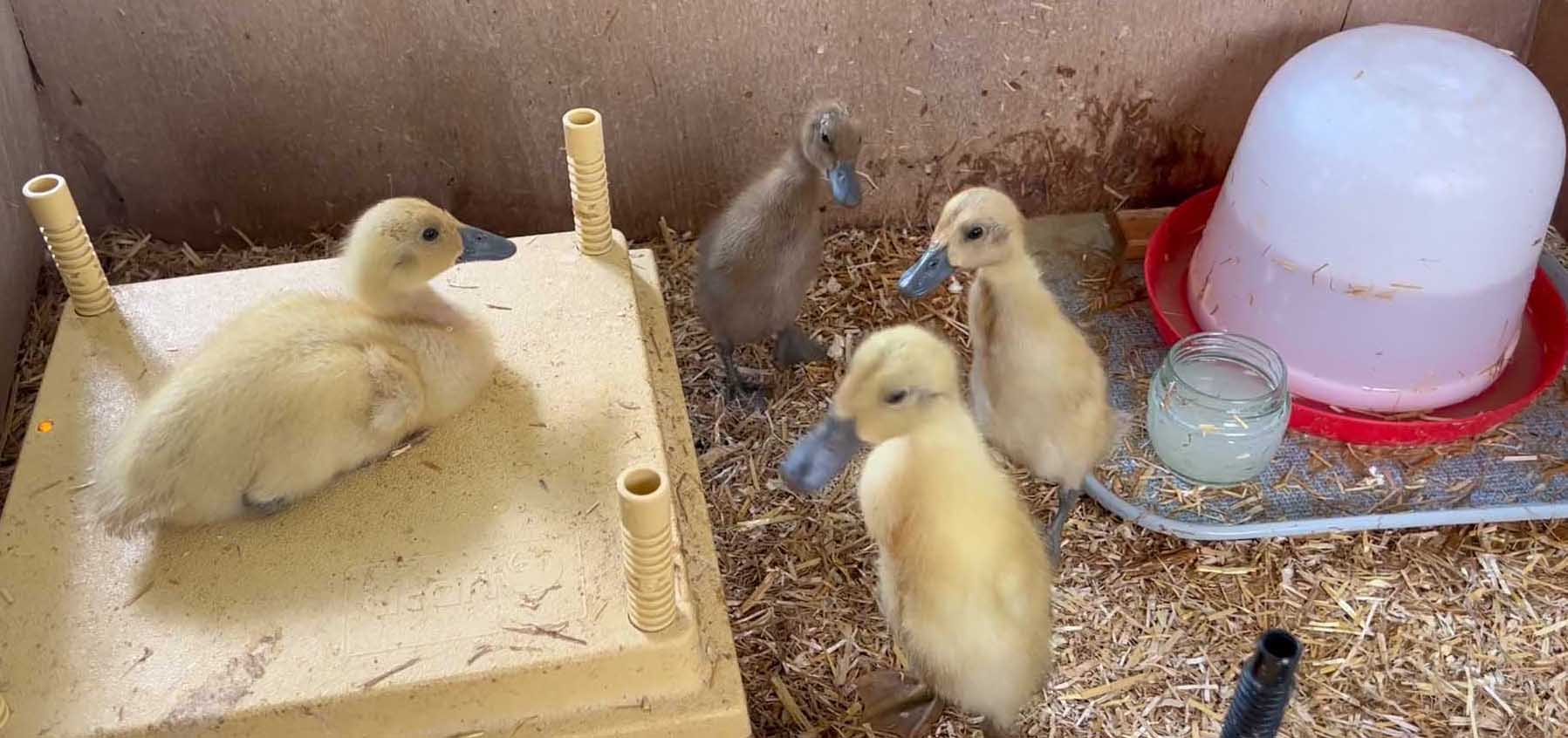Rearing Ducklings
Sitting by the river at Bourton-on-the-Water one summer, when Tom Bartlett was still at Folly Farm, we were entertained by mallard ducklings which were only a few days old. It was early evening, and the midges were out. The powder-puffs of black and yellow skittered across the water, snapping as they went. Completely water-proof, and needing no extra heat for long periods of time, it seemed amazing that they survived on this diet of insects. They completely ignored the crumbs of bread thrown in their path—and so did Mum. The wild diet is high in protein, soft, and probably easy to digest. So, the diet we feed ducks is not natural at all. However, it is very convenient, and the food manufactures have been to a lot of trouble to try and match up the vitamins, minerals and protein with the requirements of ducklings.

Ingredients
Pellets and starter crumbs for ducks and chickens are basically made from milled wheat plus beans, peas and oil seeds to increase the protein content. Manufacturers are allowed to add a certain amount of re-processed food such as pasta waste. Vitamins and minerals are added in the correct proportions and the moisture content is regulated to 13.8%. It is alleged that cheaper rations contain by-products of the wood, paper and hardboard manufacturing industry (to influence the texture of the pellet), and that harmful solvents are used in extracting soya oils for the less expensive foods. Before worrying about this too much, reflect that non-virgin oils for human consumption are probably also subjected to similar processing. However, in such foods, the pellets do seem to become rather unpalatable to waterfowl once they have become moistened outdoors in the rain, and this may be because of such additives and processing.
Crumbs
Most manufacturers make chick starter crumbs. These are pellets which have been broken up so that they will fit into tiny beaks. Crumbs which are made for poultry can be all right for ducks, but it is worth while seeking out (from the better food manufactures) starter crumbs which are designed for waterfowl. These crumbs will not contain coccidiostats which are designed to protect against coccidia infections in poultry. These coccidiostats have been tested for use with chickens in the poultry industry but, not necessarily, with ducks. If you read the label of chick starter crumbs carefully, you will find names such as ethopabate and amprolium. Although ducklings are reared on products containing these medications, some may experience adverse effects, and additive-free starter crumbs are much preferred by duck breeders. [This is especially important for Call ducks].
Starter crumbs should be fed from about 24 hours old up to about 3 weeks. The ducklings do not need to feed immediately because they have a food reserve (the yolk sac) which has been drawn inside the body around hatching time. This food reserve should be used by the duckling over the first 48 hours after hatching. However, the ducklings peck around and will peck each other’s eyes as they explore. So it is often better to give them a few crumbs, after 24 hours, to keep them occupied. They should be feeding properly by 48 hours.
Drinkers should be of the fountain type, or of a shape and size that precludes drowning. Water should always be available; it does not matter if the crumbs run out first. Dry food must not be left without water. The ducklings will continue to eat so that, when water is made available, the crumbs swell up inside the body and cause problems and even death.
Growers Pellets
As the birds grow, their beaks can deal with larger particles. Growers pellets (for ducks) can gradually be mixed in with the crumbs from 3 weeks old. By 4 weeks old, the ducklings should be managing all pellets. The protein content of crumbs is quite high (18-20%) and is too high for birds over 3-4 weeks. Even the 15-16% protein of growers pellets can cause problems (like slipped wing) and it is a good idea to introduce a small amount of fermented wheat into the diet because it has been softened and the nutrients are more readily available. When hard grain is introduced, ducklings should have access to sand and grit. They will dig into the earth of their run to find their own particles from the soil for the gizzard as well. Whole grain alone is not a suitable diet for ducklings, neither is bread.
Greens
As well as snapping at flies, wild ducklings enjoys slugs and worms which are best found in the grass early in the morning. They also pull quite a lot of grass. If you cannot rear ducklings in clean, grass-covered runs between 3–6 weeks of age, give them grass-clippings and chopped dandelions. These too are part of the natural diet and will help the ducklings grow sturdy bones. Allen & Page Smallholder products contain grass and should get your birds off to a good start. Check out their website at www.smallholderfeed.co.uk ![]() .
.
Pasted-up Bums
Starter crumbs, as you can see, are not a natural diet, and they can cause problems for tiny Call ducklings. Larger birds occasionally suffer from the anus becoming encrusted with a paste of crumb excreta. In Call ducks, this condition is thought to be made worse by chilling or a draughty environment. Call ducks definitely need checking that they are clean. They should all be picked up regularly during their first week to see that they are all right. Where the fluff around the anus is stuck, or a ball of solid waste covers the vent, a duckling can have difficulty in excreting , and can die. Affected ducklings should have a swim in a bowl of warm water. They need cleaning up and watching to make sure they do not drown. Afterwards, dry them with tissue, and keep them warm under the heat lamp.
Rearing Methods

Initially ducklings are often kept on textured paper or old clothing and moved onto a wire grid or shavings (once they are old enough to realise that shavings are not eatable). The wood shavings should be of a softer grade than the hard wood chip type used for horses.
Bales of chopped, dust extracted plain straw can work well. However, chopped straw products for bedding should be viewed with caution. Herbal additives in some products are very strong for tiny birds in close contact with them, and added eucalyptus oil will kill goslings.
Expandable bedding such as rapeseed straw might be used but there is the danger of this expandable bedding killing ducklings if they eat it i.e. the bedding fragments swell up inside them with the large amount of water they drink. It is best avoided.
Soft bedding is better for the quality of their feet than a wire platform which should only be use for a few days. But it is useful to have the water containers placed on a wire platform for drainage, or on a container to collect spillage. The bedding then remains in a better condition.

Pasted up bums only occur with dry-rearing methods which are generally practised with domestic waterfowl. Wildfowl rearers more often use wet-rearing methods. As the term suggests, the ducklings have access to paddling water, and can wash and preen themselves, and consequently do not get sticky bums. Wet-rearing needs more supervision in the first stages, but is then more suitable for young Calls.
Go to the page www.runnerduck.net/feeding.php for further information on feeding growing ducks.
Duck Food Suppliers in the UK
The Yellow Pages UK will list local distributors under Animal Feed Stuffs. Information about distributors of specialist food can also be obtained from:Allen & Page 01362 822900 www.smallholderfeed.co.uk ![]() or Marriage’s www.marriages.co.uk/products-poultry.php
or Marriage’s www.marriages.co.uk/products-poultry.php ![]()
CHICK CRUMBS CONTAINING COCCIDIOSTATS ARE BEST AVOIDED WITH CALL DUCKS - THEY MAY CAUSE PROBLEMS
Note that coccidiostats are successfully used in the poultry industry. Ducks kept in good conditions are less susceptible to coccidiosis than chicks, and don’t need the medication. Further information ![]()
Page last updated: 16th October 2023